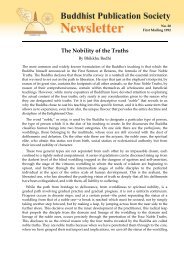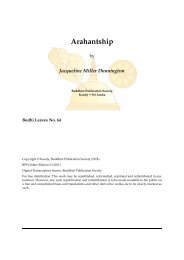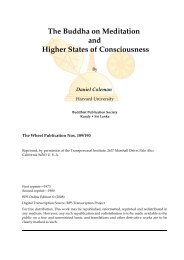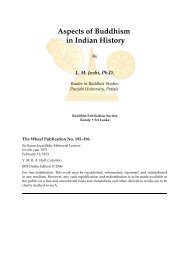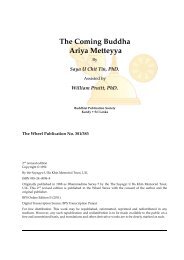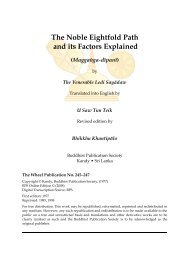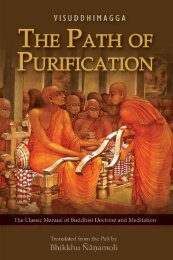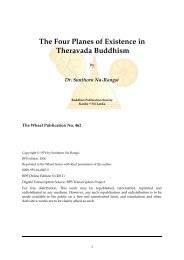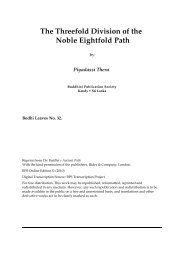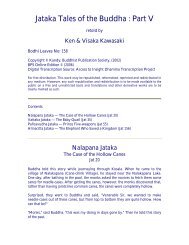Buddhism and Comparative Religion and Other Essays - Buddhist ...
Buddhism and Comparative Religion and Other Essays - Buddhist ...
Buddhism and Comparative Religion and Other Essays - Buddhist ...
You also want an ePaper? Increase the reach of your titles
YUMPU automatically turns print PDFs into web optimized ePapers that Google loves.
devoted also to other religious cults. Hence, from the <strong>Buddhist</strong> point of view, the teaching ofdeliverance can be understood <strong>and</strong> practised by different people to a very different extent,according to their inclinations <strong>and</strong> capacities. The “road to enlightenment” starts even as fardown as on the level of animals. We hear, for instance, of pious elephants <strong>and</strong> hare, or of a frogthat as reward of homage paid to the Buddha, was reborn in a devout human family <strong>and</strong>,progressing steadily, finally gained deliverance. If one wishes to have a correct idea of the<strong>Buddhist</strong> Weltanschauung <strong>and</strong> outlook on life, one has to familiarize oneself with the <strong>Buddhist</strong>conception that an incalculably large number of living beings, through thous<strong>and</strong>s of years, inthous<strong>and</strong>s of lives, proceed on their way to the light, slowly, though not without relapses. TheWestern concept that salvation depends on the moral quality of one single life must not be usedas a basis for judging <strong>Buddhist</strong> ethics. Hence the widely spread opinion that because theBuddha taught renunciation to his monks, he wanted all men to be monks, is quite erroneous<strong>and</strong> so also the idea derived from it, that <strong>Buddhism</strong> is averse to culture. Because only a fewamong the countless beings will reach Nirvāna after slow progress, therefore <strong>Buddhism</strong>, fromits very start, has provided less stringent ethical precepts for those who only gradually canachieve that maturity required for final liberation. Hence, in <strong>Buddhist</strong> countries, art <strong>and</strong> scienceshave always been cultivated, <strong>and</strong> it is not by chance that <strong>Buddhist</strong>s have been among thefounders of Indian medicine, as it was one of their foremost endeavours to help sufferinghumanity. For the great majority of <strong>Buddhist</strong>s, <strong>and</strong> this I found also in present-day Burma,Siam, China <strong>and</strong> Japan, Nirvāna is only the ultimate, distant goal to which practically only themonk is devoted. <strong>Buddhism</strong> when it flourished, was certainly not a pessimistic <strong>and</strong> life-denyingreligion. This can be seen from the fact that some of the greatest rulers of ancient India, Ashoka(250 B.C.), Kanishka (100 A.C.) <strong>and</strong> Harsha (650 A.C.), were <strong>Buddhist</strong>s.<strong>Buddhism</strong> did not establish in India an organized Church in the Western sense, <strong>and</strong> it had nocentral ecclesiastical authority laying down what was the true faith <strong>and</strong> what was not. Hencethere arose many schools <strong>and</strong> sects who differed from each other in several doctrinal issues,though all of them revered the Buddha as their Master. As enforced conversion is alien to<strong>Buddhism</strong> <strong>and</strong> as it did not dem<strong>and</strong> exclusive allegiance nor a formal repudiation of otherreligions, the total number of <strong>Buddhist</strong>s underwent strong fluctuations. <strong>Buddhism</strong> was neverthe dominant religion of India, <strong>and</strong> it was always only a section of the population that professedit. Even at periods of its widest dissemination on the Indian subcontinent, Brahmanism alwaysremained a strong force. When, since about the 8 th century A.C., Brahmanism came to the foreagain <strong>and</strong> vigorous religious movements arose in its midst to which an ageing <strong>Buddhism</strong> wasno match, Gautama Buddha’s teaching almost vanished in India. Similarly, as Christianitywhich in present-day Palestine counts only very few followers but instead had conquered alarge part of the world, so also <strong>Buddhism</strong> found in the Far East <strong>and</strong> in South-East Asia richcompensation for the loss in India. In Burma, Thail<strong>and</strong>, Cambodia, <strong>and</strong> Laos, in Tibet, Sikkim,<strong>and</strong> Bhutan almost the whole population is <strong>Buddhist</strong>; in Ceylon it is a large majority; <strong>and</strong> inChina, Korea, <strong>and</strong> Vietnam, <strong>Buddhism</strong> has a large number of followers, while in Japan it is thepredominant religion.Within the long history of Indian religion, the one <strong>and</strong> a half millennia of <strong>Buddhist</strong> history onIndian soil are only an episode; but it is an episode of a significance that can hardly be ratedhighly enough. <strong>Buddhism</strong> has amalgamated the currents of Indian thought in a system ofingenious synthesis which decisively influenced minds at a time of India’s political <strong>and</strong> culturalgreatness. It was through <strong>Buddhism</strong> that Indian ideas became known in most parts of Asia, <strong>and</strong>this was an achievement of cultural propag<strong>and</strong>a of a vast extent. But also in contemporaryIndia, the impact of the Buddha, his teaching <strong>and</strong> his community of monks is still very much inevidence. The formulations given by the Buddha <strong>and</strong> his disciples for fundamental concepts ofthe Indian world-view have partly been adapted by the opponents <strong>and</strong> made parts of their14




